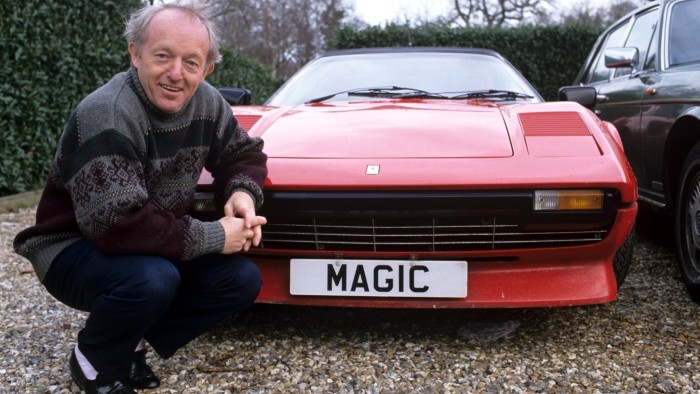Rich People’s Problems: Are personalised number plates naff?


Roula Khalaf, Editor of the FT, selects her favourite stories in this weekly newsletter.
Personalised car registration plates are publicly reviled, but privately revered. Unlike many things you can buy, there’s not much use for them. They won’t make your car go faster or be more economical. In fact, they only serve to make you more conspicuous — and possibly the subject of ridicule.
There’s a huge market in plates from the Driver and Vehicle Licensing Agency (DVLA) when they are released and from people trading them. But is it a wise way to splash some cash? As well as being quite fun, they can also be rather a good investment. But — hang on a minute. Aren’t they naff?
Naff is difficult to define these days. I am all for an expensive car. But if you drive around in a McLaren, that’s naff, as is a Lambo or a Bentley Continental (though for some reason, despite being rather footballer, the new Continental with its sleek lines and less bulbous looks may have crossed the Rubicon into cool). And in most cases a Ferrari. Unless they’re vintage.
If you add a personalised registration plate to any new car, whether it’s a cheap runaround or costs the equivalent of a small Knightsbridge apartment, you just cranked up the naffometer into the naffosphere.
With some expensive cars you should only ever be seen in the back, such as a Mercedes S class or a BMW 7 Series. A chauffeur-driven car with a private plate is, of course, naff. Unless you’re Lord Sugar with AMS 1. That’s cool.
But add the wrong registration plate, even to an Aston, and you’ll ruin everything. it’s a little bit like owning a stately home with a gnome garden, or adding net curtains to a Georgian townhouse, or putting carpet in a bathroom. Yet, add the right plate on the right car and the car is cool — and so are you.
As someone with a three-letter surname that can fit on to a registration plate, you might assume that I’d have “MAX”. I would not be the first member of my family to do so. But I don’t — though I confess my uncle did buy me another, consisting of a series of Js, for my 21st birthday.
Increasingly, as the prices shoot up, I realise this has been an error. Years ago, I had the opportunity to buy a “MAX” plate with a low number — though sticking that on a Mercedes SLK would just have made the hairdresser image worse.
Much the cheapest way of purchasing a personalised number plate is to buy one on registration. It’s difficult to say just how much the DVLA has raised from selling private plates, but one report suggested that over the past 25 years, it has raked in £2bn for HM Treasury. From £599 you can go directly to the DVLA website and select your plate. But it won’t really be a personalised plate that’s likely to have much value. It’s just a bit of fun.
If it’s an investment you want, not a plaything, you might begin your research by looking on the DVLA website to discover auction results for plates you might like to own. Back in April 1997, I was surprised to find that BOG 1E sold for £21,500. Even now that’s rather a lot of money for a snotty old registration plate. And I suspect it’s worth a lot more today. BO66 OFF is available now for £9,545, if you fancy it, though you might find yourself in competition with Charlie Mullins of Pimlico Plumbers fame, who has ensured every one of his brightly coloured vehicles has a plumbing plate reference.
The original source for the registration plate enthusiasts is The Motor Car Act of 1903, which lifted the idea from the Dutch. Various prefixes and suffixes were assigned, according to where the plate originated. At first there was no centralised system, so this was administered by local authorities.
These early plates — issued on a first come, first served basis — tend to command the biggest prices. The Queen has the plate A 7. Who knows what that’s worth? A 1 was secured by Earl Russell and Buck House must have been seventh in the queue. It’s now rumoured to be owned by the brother of the Sultan of Brunei and worth more than £1m.
There aren’t many examples of these low number plates trading. But when they do, prepare to spend hundreds of thousands of pounds. “25 O” was sold by the DVLA in 2014 to Ferrari dealer John Collins for £518,000. Arguably, it was worth it, since there is a ready demand of people wanting to buy low numbered pre-1963 plates.
In 1963, the system changed to bring in the suffix, marking the year of the “A” plate. These can genuinely spell a word, such as Jimmy Tarbuck’s COM1C or the late Paul Daniels’ MAG1C. Again, be prepared to get your wallet out.
By 1983 they had run out of letters, so they reversed it all to the prefix plate. In 2001 the current, rather utilitarian, system was introduced, which is a bother if you want to spell words or have fancy plates. Rarity, age, one-off words or brevity create value.
From personal experience, the more recent plates are just a tax rather than an investment. But there’s an opportunity right now for me to rinse my bank account. The late disgraced former PR guru Max Clifford’s plate “100 MAX” is for sale. £16,495 will secure it. Should I buy it? Or maybe I should invest in my career with 90 FT on sale for £12,995?
I don’t think so. But one day you’re bound to see me swanning around in a car with a personalised registration plate — because I’ll bung it on a Triumph Stag and I know you want one of those too.
James Max is a property expert and radio presenter. The views expressed are personal. Twitter: @thejamesmax. If you have a problem for James, contact him at richpeoplesproblems@ft.com
This article has been amended to reflect the fact that DVLA passes all money raised from selling plates to HM Treasury.
Comments